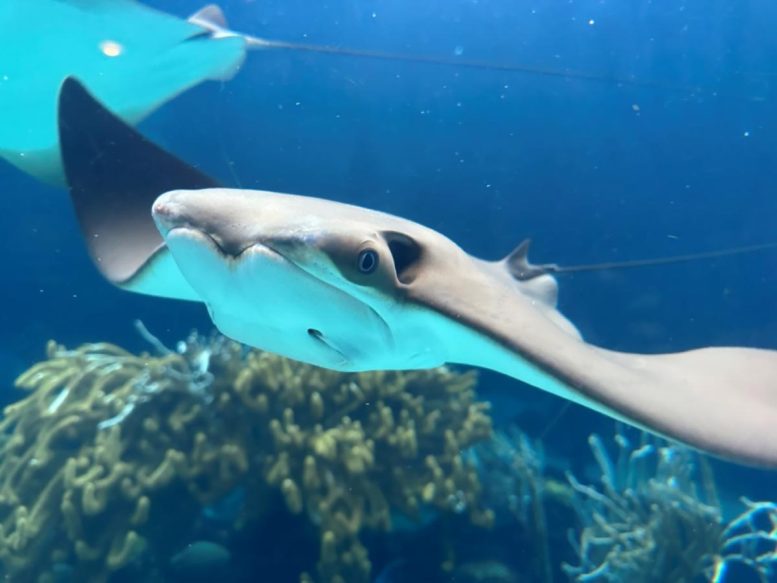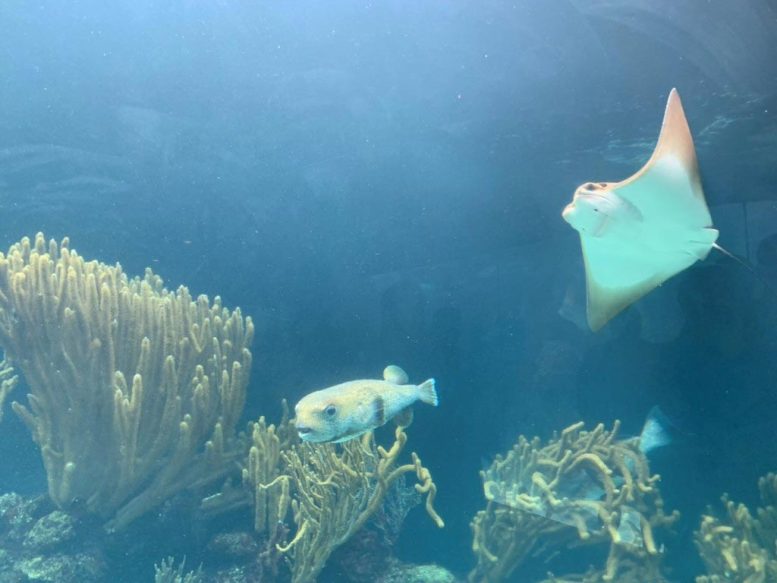Researchers have confirmed that Atlantic cownose rays, usually found near continental shelves, have migrated to Bermuda, potentially influenced by unusual oceanographic and atmospheric conditions.
For centuries, the whitespotted eagle ray (Aetobatus narinari) was thought to be the only inshore stingray species in Bermuda. However, recent research has unveiled a newcomer: the Atlantic cownose ray (Rhinoptera bonasus).
Researchers from Florida Atlantic University’s Harbor Branch Oceanographic Institute utilized citizen science, photographs, and on-water observations, combined with morphological and genetic analysis, to confirm the presence of the Atlantic cownose ray in Bermuda. Published in the journal Frontiers in Fish Science, this study marks the first documentation of such a migration event, introducing a new marine species to the region.
Geographic Significance and Behavioral Patterns
The Atlantic cownose ray is a highly migratory species that typically inhabits tropical and temperate seas near continental shelves. Bermuda, located about 1,000 kilometers from the continental mainland of the United States in the northwest region of the Sargasso Sea, is an unusual habitat for these rays. It remains unknown whether these rays are just seasonal visitors or if they have become permanent residents.
“We don’t exactly know how many Atlantic cownose rays are actually present in Bermuda and whether it’s a single group that keeps getting re-sighted in various locations or whether the species is more broadly distributed across inshore sounds and harbors,” said Matt Ajemian, Ph.D., the study’s lead author and a director at the Fisheries Ecology and Conservation Lab at FAU Harbor Branch.
Collaborative Research and Data Collection
For the study, recent information on cownose rays from Bermuda was compiled using informal, personal communications with fisheries officers and staff, photographs by local citizen scientists, and recent on-water observations and collections. Researchers also extracted DNA from tissue samples of five individual cownose rays between 2021 and 2022.
The research was conducted in collaboration with FAU Harbor Branch, The University of Southern Mississippi, the Department of Environment and Natural Resources, St. George, Bermuda, the Natural History Museum, the Bermuda Aquarium, Museum and Zoo, and NOAA Fisheries.
Reproductive Behavior and Environmental Triggers
Outmigration of cownose rays along the Atlantic coast is triggered by various factors such as temperature. Along the Atlantic coast of the U.S., northward migration cues for females and males depend on different factors: sea surface temperature for females and day of year for males.
“Although all of the cownose rays in Bermuda to date are females, we also observed small, immature rays suggesting pupping may have recently occurred here,” said Ajemian. “Moreover, there have been reports of behaviors indicative of copulation, including close following and biting of pectoral fins that suggests male rays are also present in the area.”
The study also offers another probable mechanism that may have facilitated this recent expansion of Atlantic cownose rays to Bermuda – oceanography. “Atmospheric conditions including wind and extreme weather events such as storms have been shown to trigger abnormal migratory behaviors in other large marine animals such as loggerhead sea turtles,” said Ajemian.
Interestingly, during the time period preceding the expansion of cownose rays to Bermuda (winter 2010), the North Atlantic Ocean experienced a pronounced southward shift in westerly winds that were also unusually strong and influenced current dynamics in the region. This transition facilitated an unprecedented push of floating Sargassum seaweed toward the eastern Atlantic, including Bermuda.
“This climatological anomaly and associated oceanographic changes may have played a similar role in shifting cownose rays eastward from their established range to Bermuda,” said Ajemian. “Extensive tropical storm activity also occurred between Bermuda and the continental U.S. in the years leading up to the first claimed sighting of cownose rays and could have displaced these animals offshore into the Gulf Stream.”
Similarly, in 1609, the Sea Venture, a 17th-century English sailing ship encountered a tropical storm and was shipwrecked with her crew and passengers landing on the uninhabited Bermuda. “Perhaps these Atlantic cownose rays encountered bad weather just like the Sea Venture did and found their new paradise in Bermuda,” said Ajemian. “In the end, we don’t know if it was a single event or a combination of conditions that brought these animals here, but either way it’s an incredible trip!”
Long-term Presence and Future Research
Findings from the study suggest that cownose rays have been in Bermuda for more than a decade since 2012 and observations of the species continue to be sustained today.
“If cownose rays continue to survive in Bermuda waters, the species’ low fertility rate of one pup per year will limit its capacity for rapid population growth, which is why we greatly need a more accurate assessment of the current population size.”
Researchers suggest gleaning this information using systematic aerial surveys and monitoring size classes to determine the level of reproductive success of the established population. Furthermore, collecting dietary information will help to identify the prey resources that the species are interacting with and whether any of these are shared with the protected whitespotted eagle ray. Fortunately, the two species co-exist in other regions, but space is limited in Bermuda so the researchers remain cautious of potential competition.
“We need more research into the potential mechanisms that facilitated the arrival of cownose rays to Bermuda, as this could reveal whether additional introductions of this species and others are possible in the future,” said Ajemian.
Reference: “Recent expansion of the Atlantic cownose ray (Rhinoptera bonasus) into Bermudian waters” by Matthew J. Ajemian, Cecilia M. Hampton, Lauren M. Coleman, Joanna M. Pitt, Struan R. Smith, Christian M. Jones and Nicole M. Phillips, 18 April 2024, Frontiers in Fish Science.
DOI: 10.3389/frish.2024.1394011
Study co-authors are Ceclia Hampton, a graduate student at FAU Harbor Branch; Lauren M. Coleman, The University of Southern Mississippi; Joanna M. Pitt, Ph.D., Department of Environment and Natural Resources, Bermuda; Struan R. Smith, Ph.D., Bermuda Natural History Museum; Christian M. Jones, Ph.D., NOAA Fisheries; and Nicole M. Phillips, Ph.D., The University of Southern Mississippi.
https://news.google.com/rss/articles/CBMiaWh0dHBzOi8vc2NpdGVjaGRhaWx5LmNvbS9zdXJwcmlzaW5nLWRpc2NvdmVyeS1hdGxhbnRpYy1jb3dub3NlLXJheXMtaW4tYmVybXVkYS1saW5rZWQtdG8tY2xpbWF0ZS1hbm9tYWx5L9IBAA?oc=5Bagikan Berita Ini


















0 Response to "Surprising Discovery: Atlantic Cownose Rays in Bermuda Linked to Climate Anomaly - SciTechDaily"
Post a Comment